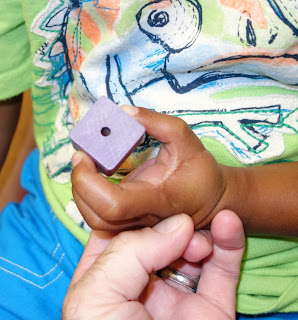Pollicization is the surgical procedure in which the index finger (typically) is used to create a thumb. It is most commonly performed for children born without a thumb or with a markedly small, unstable thumb but can also be performed in post- trauma situations in the adult. The importance of a good thumb can not be overstated: first, it allows large object grasp (grabbing a soda can). While one may be able to grab a soda can between the index and long finger, it is difficult as most of us do not have a big enough space to accomplish that goal. The second reason that the thumb is so important is small object fine manipulation. It is true that one can manipulate beads or blocks between the index and long finger BUT, when you do so, you are using the sides of these two fingers which is a challenge. It is much easier when one uses the pulpy part of the finger/ thumb to accomplish this goal.
So when the thumb is not suitable, the pollicization procedure is a great option because it really helps function. There is an added benefit that it also really helps appearance as well. A hand with a thumb (or pollicized digit) and 3 fingers looks almost normal and is almost never noticed as being abnormal. However, a four fingered hand without a thumb is always noticed.
So, in case you can’t tell, I (and others who share my passion for congenital hand surgery) really feel strongly that the pollicization procedure is a great operation for the right child (and family). The risks are relatively low for such a procedure and the results are really predictable and good. However, it is also an operation that is slightly different based on the surgeon. Dr Manske, my former mentor and partner and a father of this field of surgery, published a “cookbook” of how to actually perform the procedure. The 10- step process really does break it down nicely into straightforward steps. http://www.ncbi.nlm.nih.gov/pubmed/1572922
But, the pollicization procedure, as much as any procedure I know in orthopaedic surgery, is really affected by the surgeon and the small decisions that the surgeon makes during the surgery. We have written on some of the factors that affect the appearance outcome of pollicization http://www.ncbi.nlm.nih.gov/pubmed/17826558.
Some factors are out of the control of the surgeon and these factors include mobility (the most important factor affecting the outcome of the pollicization procedure is the quality/ mobility of the index finger), girth or size, nail width, among others. However the surgeon can control some really important features including length, position of the web space, angulation (sometimes), mobility (to some degree), and perhaps most importantly, rotation. None of these are easily controlled and, I believe, the decision- making comes with years of experience and lots of procedures performed. It is why I believe that the best way to learn the entire field of congenital hand surgery is with a mentorship model- meaning that I feel that to be high quality congenital hand surgeon, one needs to learn from another very experienced congenital hand surgeon over time). After all of my training (college, 4 years of medical school, 5 years of residency in orthopaedic surgery, and 1 year of fellowship in hand surgery), I had the pleasure/ honor of learning for another 10 years with Dr. Manske. While I was certainly well- enough trained to perform the procedure immediately after I finished those years of training, I feel the extra years helped me immensely and helped to make me a better surgeon today.
My advice to parents considering this procedure is to understand the surgeon’s training and the number of pollicization procedures that the surgeon performs each year. He or she should be willing to share that information and if the topic is uncomfortable for discussion, to me, that is not ok. Ask to see pictures of previous cases, talk to other patients, etc.
Here is a child after bilateral wrist procedures and pollicizations (1+ year out from last pollicization). The left side, to me, looks wonderful and functions beautifully. The right side works really well also but was more of a challenge as there was limited motion before surgery and so we made some decisions to help function at a slight cost of appearance. The right side is rotation differently compared to the left and is a bit longer. These are trade offs. Mom and child are both very happy and he uses BOTH thumbs wonderfully.
 |
| Bilateral pollicization. Left side is a bit more natural appearing due to decisions to maximize function on right. |
 |
| Left side pollicization. |
 |
| Left side pollicization demonstrating pinch. |
 |
| Right side pollicization. Thumb is slightly longer than usual to make up for decreased motion. |
 |
| Left sided small block pinch after pollicization. |
 |
| Left sided large block grasp after pollicization. |